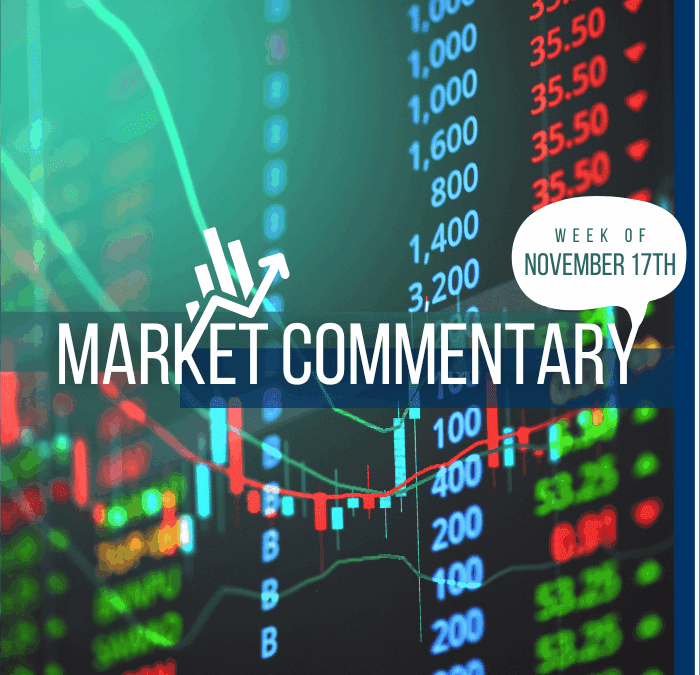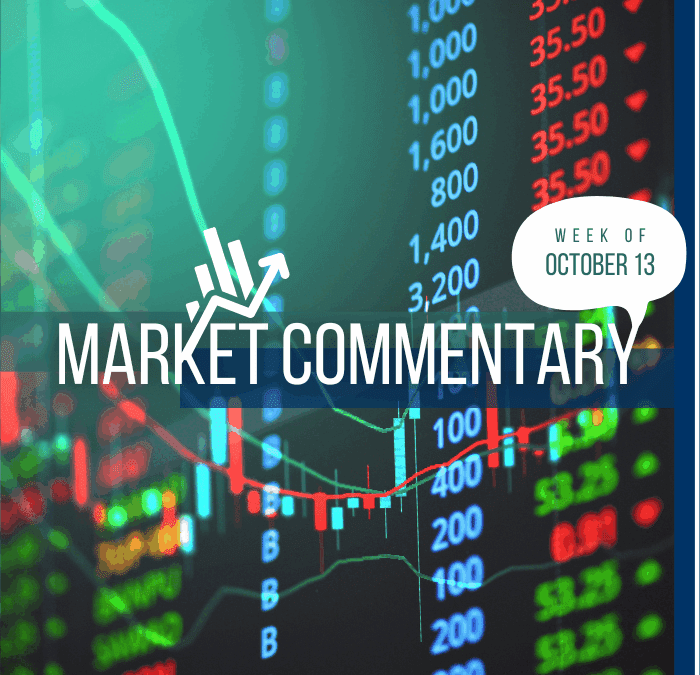
Market Commentary | November 17th, 2025
Weekly Market Commentary
November 17th, 2025
Week in Review…
This week’s economic data offered a multifaceted view of market sentiment as investors weighed inflation risks, interest rate expectations, and energy supply dynamics. With the Federal Reserve maintaining a cautious stance, attention turned to Treasury auctions and oil inventories for signals on how financial and commodity markets are responding to evolving macroeconomic conditions.
On November 12, the U.S. Treasury auctioned $42 billion in 10-year notes at a yield of 4.074%, with a bid-to-cover ratio of 2.43, slightly below the recent average. The muted demand suggests investors remain cautious about long-term interest rate risk, likely reflecting persistent inflation concerns and uncertainty around the Fed’s policy path.
The following day, the 30-year bond auction saw $25 billion issued at a yield of 4.694%, with a bid-to-cover ratio of 2.29. This was also below trend, reinforcing the notion that investors are hesitant to lock in capital at current long-term rates, possibly anticipating further tightening or inflation persistence.
Meanwhile, the EIA’s crude oil inventory report showed a 6.4 million barrel build, well above expectations. While gasoline and distillate inventories declined, the headline increase in crude stockpiles points to a temporary supply-demand imbalance, which could ease some inflationary pressure in energy markets.
Taken together, these indicators reflect a market grappling with elevated yields, inflation uncertainty, and shifting energy fundamentals. The soft bond auction results underscore investor wariness, while the oil inventory build may offer modest relief on the inflation front.
Week Ahead…

The upcoming week features several high-impact releases that could shape monetary policy expectations and market sentiment.
On Wednesday, November 19, the Federal Open Market Committee (FOMC) Meeting Minutes will offer insight into the Fed’s internal discussions. With inflation still elevated and labor market data softening, investors will closely examine the tone for clues on future rate decisions.
Also on Wednesday, the EIA’s crude oil inventory report will be closely watched following last week’s unexpected 6.4 million barrel build. Another increase could signal easing energy demand, while a drawdown may point to resilient consumption and renewed inflationary pressure.
On Thursday, November 20, the existing home sales report for October will provide a snapshot of housing market momentum. After a modest rebound in September, analysts expect sales to remain flat or decline slightly due to high mortgage rates and tight inventory. This data will help gauge consumer demand in one of the most rate-sensitive sectors.
Finally, on Friday, November 21, the S&P Global Flash Purchasing Managers’ Indexes (PMIs) for manufacturing and services will offer a timely read on business activity. October’s manufacturing PMI rose to 52.5, while services edged up to 54.8, both signaling modest growth. November’s data will be key in assessing whether the economy is maintaining momentum or beginning to slow under tighter financial conditions.
Together, these releases will help shape expectations for the Fed’s December meeting and broader economic trajectory.
Economic Indicators:
- CPI: Consumer Price Index measures the average change in prices paid by consumers for goods and services over time. Source: Bureau of Labor Statistics.
- Core CPI: Core Consumer Price Index excludes food and energy prices to provide a clearer picture of long-term inflation trends. Source: Bureau of Labor Statistics.
- PPI: Producer Price Index measures the average change in selling prices received by domestic producers for their output. Source: Bureau of Labor Statistics.
- Core PPI: Core Producer Price Index excludes food and energy prices to provide a clearer picture of long-term inflation trends. Source: Bureau of Labor Statistics.
- PCE: Personal Consumption Expenditures measure the average change in prices paid by consumers for goods and services. Source: Bureau of Economic Analysis.
- Core PCE: Core Personal Consumption Expenditures exclude food and energy prices to provide a clearer picture of long-term inflation trends. Source: Bureau of Economic Analysis.
- Industrial Production: Measures the output of the industrial sector, including manufacturing, mining, and utilities. Source: Federal Reserve.
- Mfg New Orders: Measures the value of new orders placed with manufacturers for durable and non-durable goods. Source: Census Bureau.
- Durable New Orders: Measures the value of new orders placed with manufacturers of durable goods. Source: Census Bureau.
- Durable Inventories: Measures the value of inventories held by manufacturers for durable goods. Source: Census Bureau.
- Consumer Confidence (CB, 1985=100): Measures the degree of optimism that consumers feel about the overall state of the economy and their personal financial situation. Source: Conference Board.
- ISM Manufacturing Report: Measures the economic health of the manufacturing sector based on surveys of purchasing managers. Source: Institute for Supply Management.
- ISM Non-Manufacturing Report: Measures the economic health of the non-manufacturing sector based on surveys of purchasing managers. Source: Institute for Supply Management.
- Leading Economic Index: Measures overall economic activity and predicts future economic trends. Source: Conference Board.
- Building Permits (Mil. of Units, saar): Measures the number of new residential building permits issued. Source: Census Bureau.
- Housing Starts (Mil. of Units, saar): Measures the number of new residential construction projects that have begun. Source: Census Bureau.
- New Home Sales (Mil. of Units, saar): Measures the number of newly constructed homes sold. Source: Census Bureau.
- SA: Seasonally adjusted.
- SAAR: Seasonally adjusted annual rate.
Market Indices & Indicators:
- S&P 500: A market-capitalization-weighted index of 500 leading publicly traded companies in the U.S., widely regarded as one of the best gauges of large U.S. stocks and the stock market overall.
- Dow Jones 30: Also known as the Dow Jones Industrial Average, it tracks the share price performance of 30 large, publicly traded U.S. companies, serving as a barometer of the stock market and economy.
- NASDAQ: The world’s first electronic stock exchange, primarily listing technology giants and operating 29 markets globally.
- Russell 1000 Growth: Measures the performance of large-cap growth segment of the U.S. equity universe, including companies with higher price-to-book ratios and growth metrics.
- Russell 1000 Value: Measures the performance of large-cap value segment of the U.S. equity universe, including companies with lower price-to-book ratios and growth metrics.
- Russell 2000: A market index composed of 2,000 small-cap companies, widely used as a benchmark for small-cap mutual funds.
- Wilshire 5000: A market-capitalization-weighted index capturing the performance of all American stocks actively traded in the U.S., representing the broadest measure of the U.S. stock market.
- MSCI EAFE Index: An equity index capturing large and mid-cap representation across developed markets countries around the world, excluding the U.S. and Canada.
- MSCI Emerging Market Index: Captures large and mid-cap representation across emerging markets countries, covering approximately 85% of the free float-adjusted market capitalization in each country.
- VIX: The CBOE Volatility Index measures the market’s expectations for volatility over the coming 30 days, often referred to as the “fear gauge.”
- FTSE NAREIT All Equity REITs: Measures the performance of all publicly traded equity real estate investment trusts (REITs) listed in the U.S., excluding mortgage REITs.
- S&P U.S. Aggregate Bond Index: Represents the performance of the U.S. investment-grade bond market, including government, corporate, mortgage-backed, and asset-backed securities.
- 3-Month T-bill Yield (%): The yield on U.S. Treasury bills with a maturity of three months, reflecting short-term interest rates.
- 10-Year Treasury Yield (%): The yield on U.S. Treasury bonds with a maturity of ten years, reflecting long-term interest rates.
- 10Y-2Y Treasury Spread (%): The difference between the yields on 10-year and 2-year U.S. Treasury bonds, often used as an indicator of economic expectations.
- WTI Crude ($/bl): The price per barrel of West Texas Intermediate crude oil, a benchmark for U.S. oil prices.
- Gold ($/Troy Oz): The price per troy ounce of gold, a standard measure for gold prices.
- Bitcoin: A decentralized digital currency without a central bank or single administrator, which can be sent from user to user on the peer-to-peer bitcoin network.
This content was developed by Cambridge from sources believed to be reliable. This content is provided for informational purposes only and should not be construed or acted upon as individualized investment advice. It should not be considered a recommendation or solicitation. Information is subject to change. Any forward-looking statements are based on assumptions, may not materialize, and are subject to revision without notice. The information in this material is not intended as tax or legal advice.
Investing involves risk. Depending on the different types of investments there may be varying degrees of risk. Socially responsible investing does not guarantee any amount of success. Clients and prospective clients should be prepared to bear investment loss including loss of original principal. Indices mentioned are unmanaged and cannot be invested into directly. Past performance is not a guarantee of future results.
The Dow Jones Industrial Average (DJIA) is a price-weighted index composed of 30 widely traded blue-chip U.S. common stocks. The S&P 500 is a market-cap weighted index composed of the common stocks of 500 leading companies in leading industries of the U.S. economy. The NASDAQ Composite Index is a market-value weighted index of all common stocks listed on the NASDAQ stock exchange.
Securities offered through Cambridge Investment Research, Inc., a broker-dealer, member FINRA/SIPC, and investment advisory services offered through Cambridge Investment Research Advisors, Inc., a Registered Investment Adviser. Both are wholly-owned subsidiaries of Cambridge Investment Group, Inc. V.CIR.1125-4232
For financial professional use only.












